Stephy Mavididi has become Montpellier’s first permanent signing of the 2020 summer transfer window. The Arsenal youth academy product has made the move to La Paillade from Juventus for just over £5.5m.
Mavididi spent last season on loan with Montpellier’s fellow Ligue 1 competitors FCO Dijon and the attacker ended the 2019/20 campaign as Dijon’s top goalscorer in all competitions, after bagging eight goals in 28 appearances for Les Hiboux, five of which came in the league.
Mavididi showed his quality in France’s top tier last season, helping Dijon to avoid relegation and the former England U20 international also displayed plenty of versatility as he featured in a variety of different positions across Dijon’s attack last term.
In this tactical analysis in the form of a scout report, we will look at some of the key aspects of Mavididi’s game during the 2019/20 season. We will look at how he performed within Dijon’s tactics last season, as well as how the 22-year-old may fit into Montpellier’s tactics next season, in this analysis.
Positioning and defensive work rate
Mavididi has primarily played as a centre forward throughout his career. However, last season, he was deployed in a variety of different positions for Dijon, who primarily utilised a 4-4-2 shape during the 2019/20 campaign, including the right and left midfield positions, where he frequently featured.
The ex-Arsenal man displayed a large degree of versatility by performing in these unfamiliar roles last season. While the attacker has been used to spending the majority of his time in the box or playing off the last shoulder of the opposition defence throughout his career, he often found himself occupying deeper positions both in and out of possession last season for Dijon.
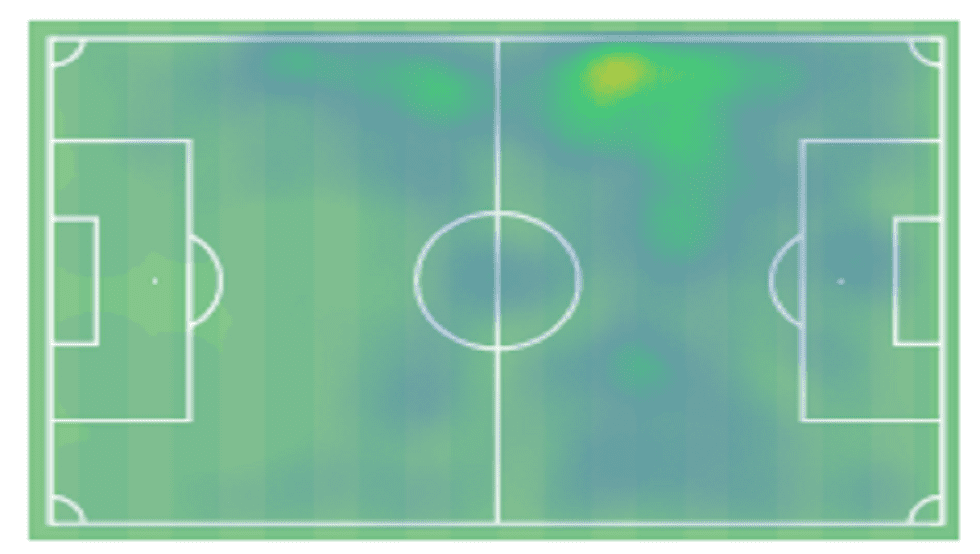
The image above shows us Mavididi’s Ligue 1 heatmap for the 2019/20 campaign and here, we can see that while he covered a large variety of different areas on the pitch last season as a result of having played in plenty of different roles last term, the attacker spent plenty of his time on the left-wing. When deployed on the left-wing, he positioned himself quite wide and this is why we can see plenty of colour out almost as far as the touchline in this heatmap.
Furthermore, we can also see plenty of colour deep on the left-wing inside what would have been Dijon’s own half in this image, which indicates that Mavididi was deployed quite deep at times.
Dijon weren’t a side that were known for pressing particularly aggressively to try and win the ball high up the pitch last season. Their PPDA of 387.62 for the 2019/20 Ligue 1 season was the third-highest in the league, indicating that their opponents were generally allowed to make a relatively high number of passes against them and progress the ball out of their own half without too much trouble last season.
Dijon also made 50% of their ball recoveries inside their own third of the pitch last season and only one side in France’s top tier – Metz – made more recoveries than that inside their own third of the pitch. This, combined with their relatively high PPDA, indicates that Dijon liked to defend quite deep last season and particularly when he was deployed as a right or left-sided midfielder, this meant that Mavididi had an important and disciplined role to play within Dijon’s defensive tactics, as part of their second line of defence.
Only two Ligue 1 sides, one of them being Montpellier, engaged in more defensive duels per 90 than Dijon did last season and within Les Hiboux’s defensive tactics, all of their players were required to give effort and put at certain stages of the opposition attack, when the ball was near to them and Mavididi appeared to produce the short bursts of speed and energy that were required of him when the opposition played the ball into a position close to him, in order to try and win the ball back.

This image above was taken just after Mavididi tracked back slightly from a central attacking position when an opposition player began to make a threatening run, carrying the ball inside. We can see that the 22-year-old attacker had won back possession just prior to this image and he managed to do so after he used his impressive pace to track down the ball carrier and nick the ball away from him, subsequently allowing himself to begin a Dijon counter-attack.
Mavididi’s pace and effort were valuable for Dijon out of possession last season and the fact that he is a pacey and athletic player, in addition to being someone who generally appears to be quite happy to put in a defensive shift, may have led to him being deployed on the wing quite frequently, despite being a natural centre forward.
As we touched on previously, Montpellier also engaged in quite a high number of defensive duels last season. La Paillade engaged in an average of 68.74 defensive duels per 90, which was the highest of any side in Ligue 1. This indicates that a similar level of work-rate that was required to play for Dijon last season may have been required within Montpellier’s tactics as well and Mavididi’s impressive performances within Dijon’s system may have played an important role in La Paillade making the decision to sign the attacker up for the 2019/20 season.
Similar to Dijon, Montpellier were quite happy to play without the ball for extended periods of play last season and their organised and disciplined defensive tactics were a very significant part of their system. With that in mind, the role that Mavididi played for Dijon last season may have given him some valuable experience ahead of his move to Montpellier.
Link-up play
Mavididi’s role for Dijon out of possession last season required him to sit deep at times and when his side won back possession of the ball in these deep areas, this often resulted in the 22-year-old receiving possession deep inside of his own half.
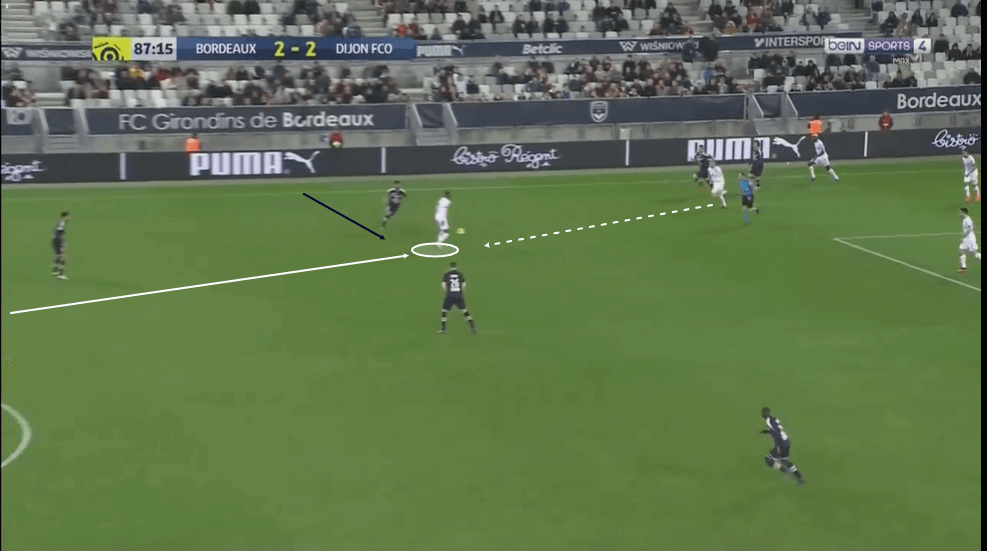
In the image above, we can see how deep Mavididi dropped on this occasion to receive the ball inside his own half just after his side won back possession. When playing centrally, Mavididi often dropped into these types of positions last season during the transition to attack, in order to help his side advance play and begin a counter-attack.
As we will discuss at greater length later, the 22-year-old is not incredibly good in the air and as a result, when playing in a central attacking position, it doesn’t make much sense for him to sit up top and wait for a long ball, as his chances of beating opposition centre-backs in the aerial duel would likely be slim.
Instead, he tended to drop deep into positions like this where he could receive the ball to feet with his back to goal and link up with his deeper teammates to try and spring an attack.
When playing in a naturally deeper position, such as one of the two wide midfield positions, Mavididi would also often receive possession in this type of area during the transition to attack, at which point the onus would be on him to carry possession forward.
When he received the ball deep while playing in one of the wide midfield positions, Mavididi’s teammates would often play the ball in front of him and when he was allowed to run onto the ball, he generally fared better than when he received the ball with his back to goal, as he did on this occasion.
The attacker didn’t usually tend to play many passes last season and when receiving the ball in this type of deep position, he would usually attempt to use his dribbling ability to carry to forward. This was a positive for some areas of his game, however, this also proved to be a negative aspect of his game with Dijon at times, as when receiving the ball in positions like this, with his back to goal and with numerous opposition players ahead of him presenting some difficult obstacles to beat, Mavididi’s individual outlook did result in attacks being squandered.
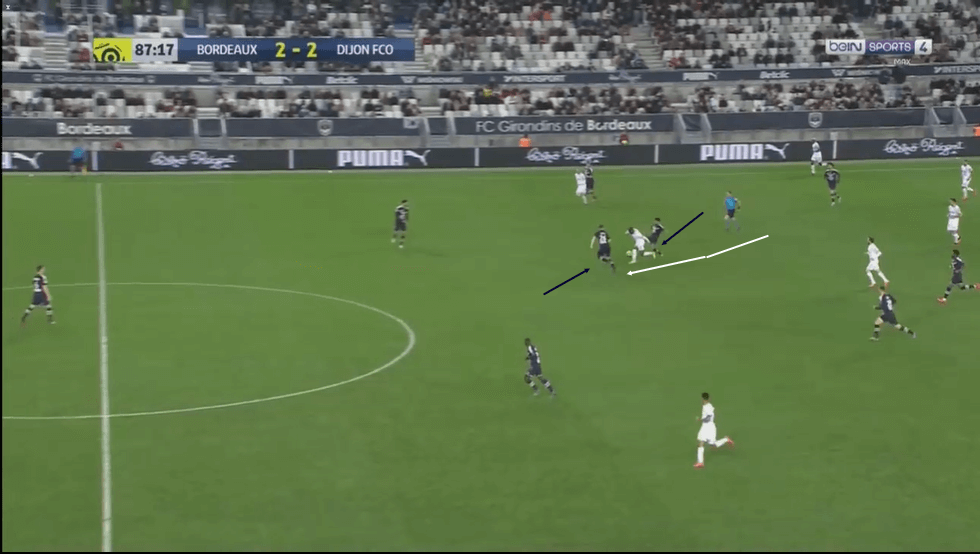
As this passage of play moved on Mavididi took the ball well and turned inside to try and take the ball away from the defender that was pressing him from the left. However, as he tried to carry the ball forward, he eventually ends up in a 1v2 situation and has little support from his teammates. This resulted in this counter-attack ending and Dijon’s opponents Bordeaux giving themselves some time to regroup.
Within Dijon’s tactics, Mavididi was often required to drop to receive the ball to feet with his back to goal like this during the build-up, even in more advanced areas of the pitch. When he received the ball like this, the 22-year-old didn’t usually pass the ball and link-up with another teammate and instead he did tend to try and go it alone, like he did on this occasion.
Mavididi’s dribbling is a key aspect of his game, as we will discuss in greater detail later on, and with that in mind, it may be understandable why the attacker did opt to go it alone in this fashion quite frequently, however, this was often ineffective when he had to drop deeper and receive possession with his back to goal because, firstly, he struggled to build up a great deal of pace quickly enough to really hurt the opposition because he had to turn on the ball and secondly because, due to the way his side set themselves up in attack, he often found himself isolated and with too many opposition defenders to have to try and beat with his dribble.
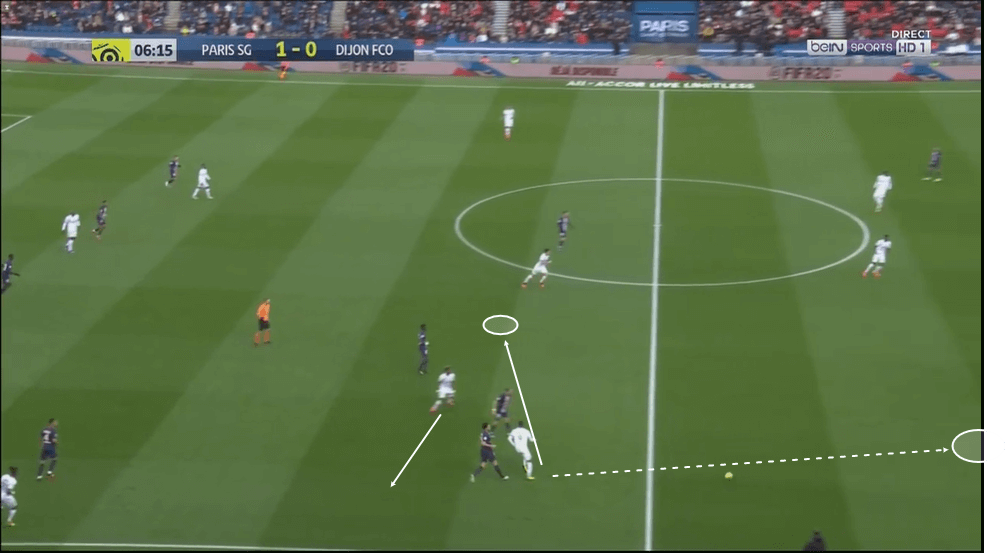
Even when deployed in a wide area, Mavididi liked to try and get central when he could. As we mentioned previously, the defensive side of his game may have played an important role in him being deployed on the wing quite often this season, however, due to the fact that he is a natural centre forward, he could, at times, be seen rotating with the near-central midfielder in possession to move inside.
Mavididi did not try to play as a traditional winger last season and due to his side’s decision to deploy him in this kind of position on occasion last season, Dijon allowed him to move inside via rotations like this one with the central midfielder during periods of possession.
As we can see, Mavididi is playing the ball back to the full-back, who is just out of shot, in this image above. He then begins to move into a central position, where he will hope to receive the ball from the full-back in some space. Meanwhile, his teammate who had been occupying the central midfield position began to shift his positioning out wide, essentially swapping with Mavididi.
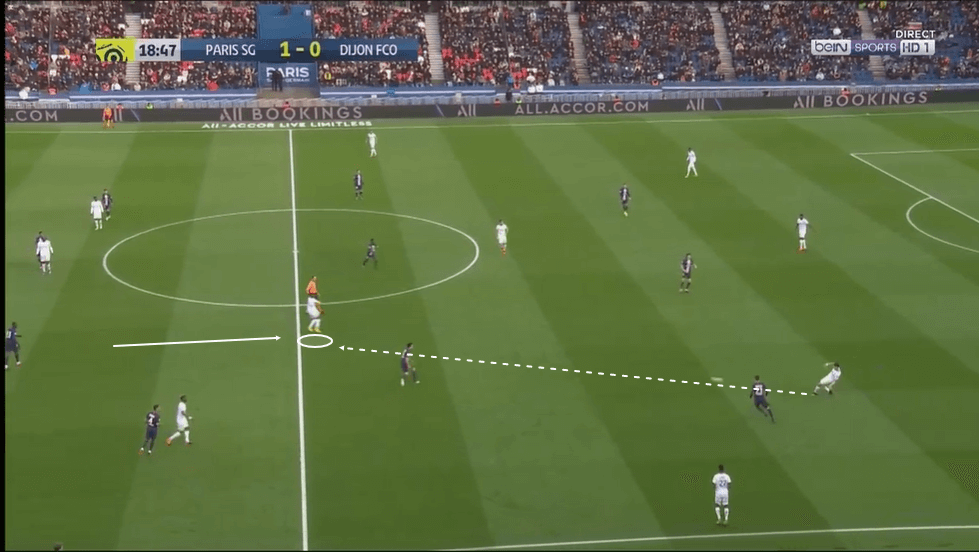
This next image shows us another example of Mavididi occupying a more central position from this same game against PSG, however, on this occasion he is already playing in a more central position and just drops in between some opposition midfielders in order to receive the ball on the half-turn between the lines and go on to carry it forward.
This image provides us with an example of how Mavididi can be effective when tasked with receiving the ball with his back to goal in a deeper area of the pitch, because he can get himself into dangerous positions between the lines where, if found unmarked, he can then turn and utilise his dribbling ability to hurt the opposition. However, this does depend on the opposition not marking him incredibly tightly and as we have seen, when they do mark him more tightly in this deep areas, that makes life quite difficult for the attacker.
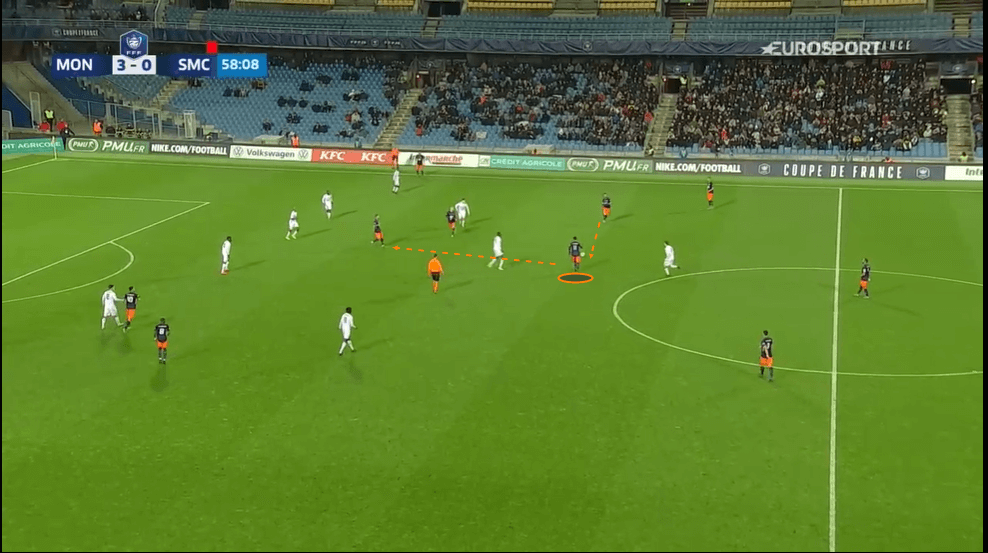
Montpellier generally lined up in a 3-4-1-2 shape last season and as we can see an example of in the image above, their forwards also dropped into these deep positions between the opposition’s defensive lines to receive the ball at times last season. This kind of movement can be dangerous for the opposition, as a player receiving the ball in this position can often enjoy plenty of time and space as the defensive side may not be 100% sure which player should be dealing with him.
A strong level of close control dribbling ability is often required in these types of situations and this is something that Mavididi can offer. Attackers will often find themselves with teammates running in behind the opposition defensive line ahead of them when they receive the ball in these types of situations and this is something that Mavididi didn’t really show that he could capitalise on last season, so from that perspective, he may not be an ideal candidate to create opportunities for his teammates from this type of position.
However, he did show that he can intelligently spot and move into space between the lines like this and he also showed that he is a confident and dangerous dribbler who is happy to take on players after linking up with his teammates to receive the ball in this kind of position, so that might be how he could be utilised in this type of scenario within Montpellier’s tactics next season.
Dribbling quality and pace
We established that dribbling is an important aspect of Mavididi’s game in the previous section of this tactical analysis piece and in this section, we will take a closer look at how his dribbling ability and his pace stood out as two of his primary qualities when playing for Dijon last season.
In addition to his defensive quality, Mavididi’s dribbling ability may be another reason that Dijon opted to deploy him on the wings quite frequently last season.
Mavididi made 6.74 dribbles per 90 in Ligue 1 last season, which was the third-highest number of attempted dribbles per 90 of any Dijon player and a higher number of attempted dribbles per 90 than any Montpellier player in France’s top tier last term. Mavididi also engaged in an average of 15.05 offensive duels per 90 in the league last season, which impressively places him in seventh place for offensive duels per 90 of any player in Ligue 1.
The newly-signed Montpellier man had a dribble success rate of 38.74% last season, which was lower than Dijon’s average of 50.6% successful dribbles.
His below-average dribble-success rate may be a result of his struggles with completing dribbles successfully after receiving the ball to feet with his back to goal and the fact that he often found himself in 1v2 or even 1v3 situations without much support from teammates, resulting in him ultimately being dispossessed, however, in 1v1 dribbling situations, his pace, agility, and technical quality helped him to perform effectively and prove a difficult opponent for defenders to handle.
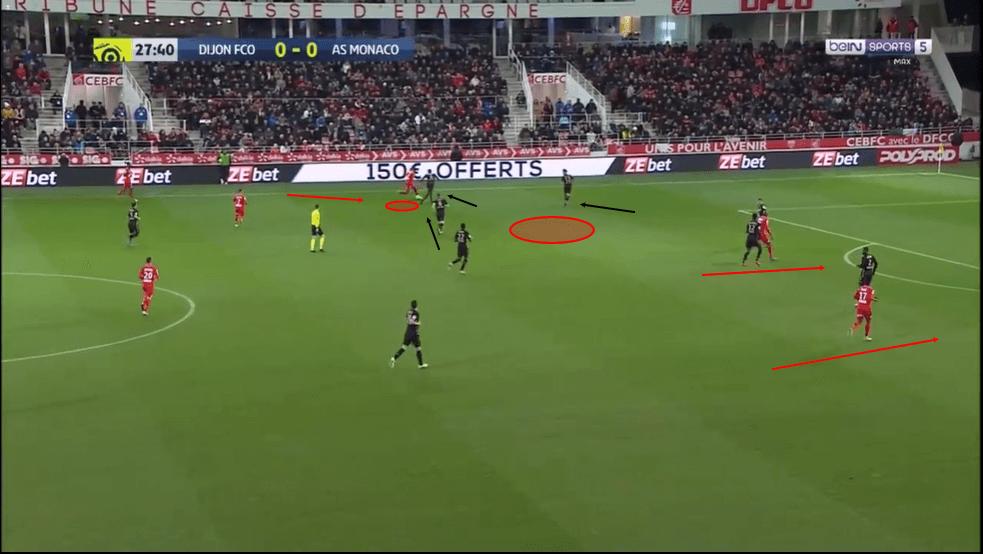
In the image above, we can see Mavididi in possession of the ball on the left-wing. Here, we can see three of his teammates positioned behind him and not in optimal passing positions at this moment as the attacker attempts to carve through the opposition defence. Meanwhile, we can also see two Dijon players positioned centrally, moving towards the penalty area.
Mavididi would benefit from some additional support here, and if a Dijon player moved into the position that is circled here, which is a position that Mavididi himself has been seen to occupy and support his teammates at times, then he could potentially link up with them to advance play. However, that doesn’t occur here and the attacker opts to take the defenders on alone, despite the fact that he has to beat both the right midfielder and right-back of the opposition side at this moment.
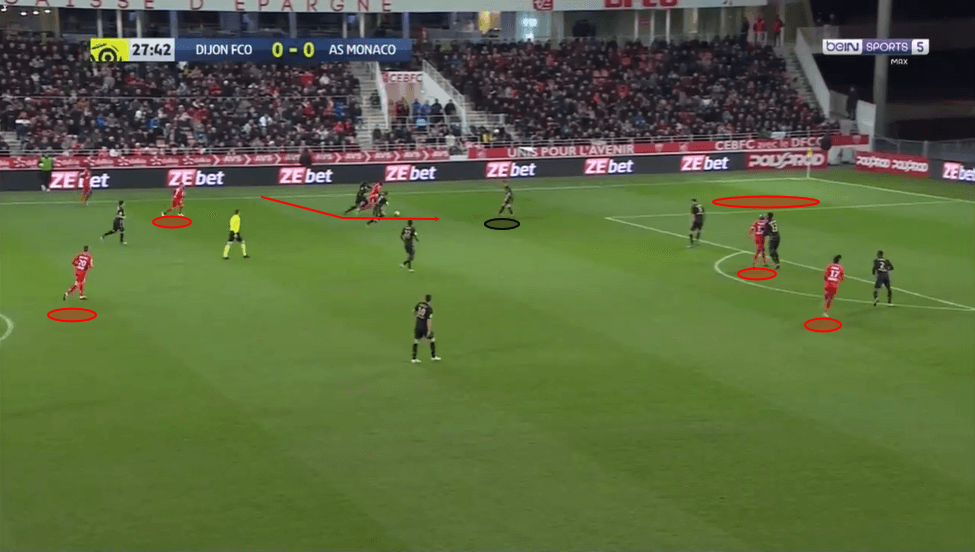
As this passage of play moves on, we see Mavididi beat the first opposition player quite easily after taking the ball inside and rounding the player, he then attempts to go back outside to beat the right-back. The two Dijon attackers in the centre continue to advance towards the penalty area, likely hoping that Mavididi gets himself into a near crossing position, such as the one that is circled high on the left-wing just outside of the penalty box in this image.
However, as this play moves on, Mavididi is stopped by the right-back, with the help of some pressure from both the right midfielder and a right central midfielder who also applied some pressure to the 22-year-old ball carrier.
While this particular dribble didn’t ultimately work out, this passage of play does show us how effective Mavididi can be in a 1v1 dribbling situation and if Montpellier manage to support him more in these positions, either creating more passing options or occupying opposition players to isolate Mavididi with one opposition defender, creating a 1v1 scenario as opposed to a 1v3 situation like the one we saw here, then he could be an even more dangerous player next season, as the dribbling quality is undoubtedly there.
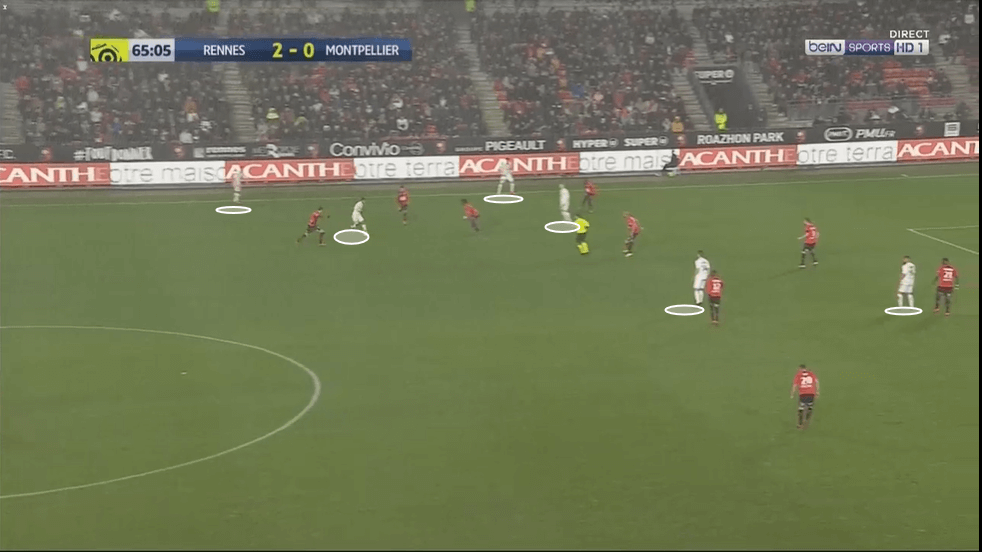
This image above provides us with an example of Montpellier, wearing white here, in possession of the ball and here, we can see that they do tend to place players in closer proximity to wide ball carriers and if Mavididi finds himself on the wing for La Paillade next season, then he may benefit from their tactics.
Furthermore, if Mavididi returns to his natural centre forward position, he may be given license to drop into the half-space himself, which could benefit his game and allow him to create more chances for his teammates via his dribbling as, if nothing else, his positioning and the threat he poses on the ball could attract opposition defenders’ attention prior to him actually doing anything in possession, which may be an exciting prospect for Montpellier and may make Mavididi an exciting addition to their attack.
As we mentioned previously, Mavididi made more dribbles per 90 than any Montpellier player last season and this includes both members of their striking duo – Gaëtan Laborde and Andy Delort. As a result, Mavididi’s dribbling may be highly coveted by Montpellier and the fact that he could offer La Paillade something different may be another reason why they decided to make him their first signing of the summer.
While Mavididi enjoys running at defenders, he may be at his most effective when running in behind the opposition’s defensive line. As a wide midfielder with Dijon last season, the attacker didn’t have as many opportunities as he may have liked to make use of this side of his game, however, Mavididi is lightning quick and he likes to play off the shoulder of the opposition’s defensive line.
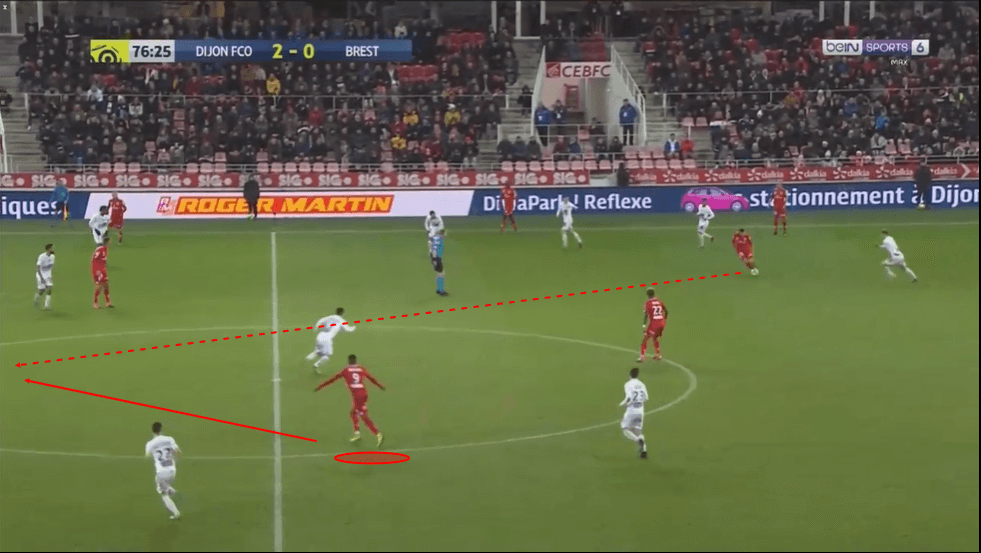
This image above shows us an example of Mavididi seeing an opportunity to drift in from a wide position to probe inside and make a run in behind the opposition’s defensive line, which he gladly does. He becomes animated and makes it clear that he wants the ball, before his teammate delivers a well-timed through ball in behind the opposition’s defensive line which Mavididi manages to meet and from that point, provided he is onside, the attacker is always going to be difficult to catch.
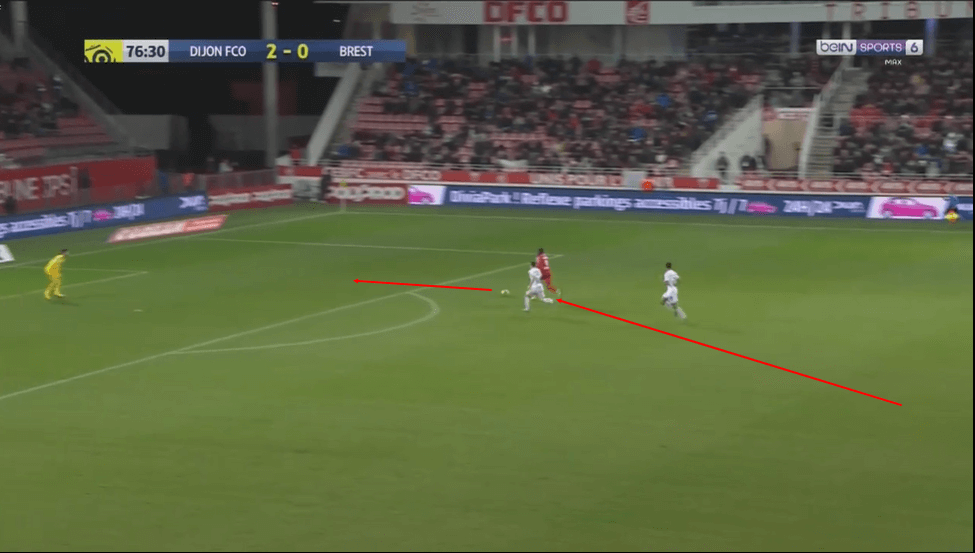
On this occasion, Mavididi is onside and he bursts forward, carrying the ball with him and essentially leaving the opposition team’s defence in his tracks. Despite moving at such high pace, Mavididi manages to retain an impressive level of composure to slot the ball past the opposition goalkeeper here.
This is an example of what may be Mavididi’s biggest threat and the most positive aspect of his game. His pace and ability to finish despite moving at high pace makes him a very dangerous player, especially for teams who play a high line, as there are not likely to be many defenders who will be able to catch him if he times his run well and is spotted by a teammate when probing in behind.
Despite playing a large number of games on the wing last season, Mavididi still managed to finish the 2019/20 campaign as Dijon’s top scorer in all competitions and he may have managed to score even more goals if this aspect of his game was highlighted more, in a central position, where he could be allowed to play off the shoulder of the opposition’s defensive line more frequently.
Montpellier’s striking duo of Delort and Laborde scored a positive total of 19 goals between them last season, however, neither of the two attackers possesses the same level of pace that Mavididi does and the addition of the 22-year-old to Montpellier’s side may increase their offensive threat and give their opponents even more to think about next season.
Despite being happy to play without the ball for large periods of the game, Montpellier scored just three goals from counter-attacks last season, as per Wyscout. This accounted for just 9% of their goals last term and was below the league average of 4.5 counter-attacking goals.
While the offensive duo of Laborde and Delort were impactful last season, they did, at times, lack pace on the counter-attack and this led to Montpellier producing some relatively slow transitions on occasion. The addition of Mavididi to their side will give them another attacking option and this option could help them to increase their threat on the counter, which may be valuable for them as a side who do spend a fair amount of time without the ball.
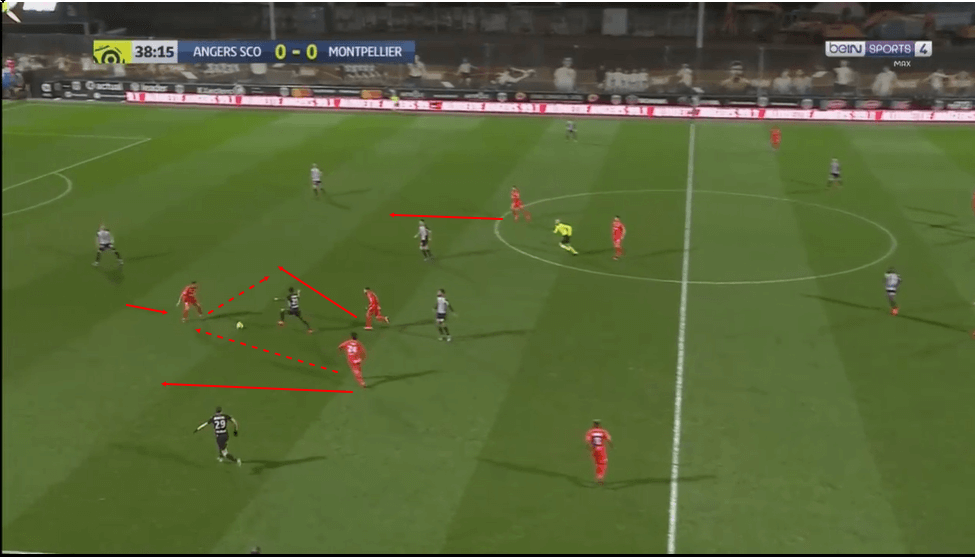
This image above shows us an example of Montpellier, in red, springing a counter-attack last season. The forward here receives the ball to feet from a midfielder, who subsequently finds another midfielder advancing from deeper to carry on the move. At the time, this attack looks as though it may result in Montpellier creating an overload versus their opponents’ defence.
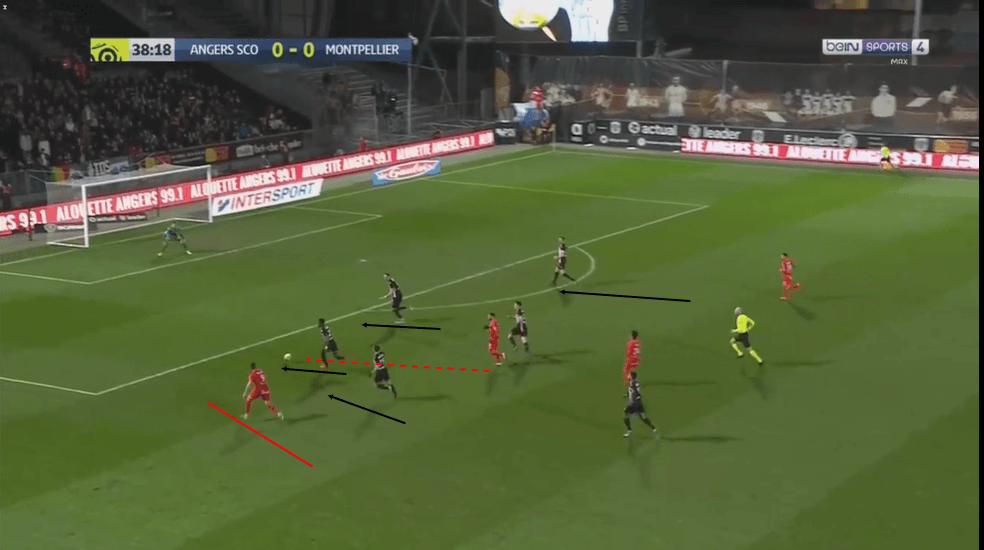
However, as play moves on, La Paillade are too slow to successfully complete this transition and threaten the opposition on the counter. The advancing midfielder who received the ball just after the previous image was taken goes on to carry it forward and attempt to play the final ball through to another attacker.
This ball doesn’t meet its intended recipient, however, as the would-be recipient is outpaced by an opposition defender. This type of scenario could suit Mavididi and his impressive level of pace well and this shows how he could benefit his new side on the counter-attack next season.
Finishing
For a forward, finishing is always going to be an important topic of discussion and considering that he ended last season as Dijon’s top scorer, despite being played from the left and right wings quite often, it may not come as a surprise that Mavididi does appear to be quite a clinical finisher.
As per Understat, the attacker outperformed his xG in Ligue 1 by 1.70 last season, which is more than any other Dijon player outperformed their xG by. Additionally, this is better than Montpellier’s current striking duo of Laborde and Delort, both of whom underperformed in front of goal compared to their xG last season.
Mavididi doesn’t generally attempt a lot of longshots, however, he is clinical inside of the box. Additionally, many of his goals come from one or two-touch finishes which don’t see him participate a great deal in the build-up. The fact that he likes to play off of the shoulder of the opposition defence may play a role in this to an extent, as a well-timed through ball that meets him running in behind the opposition’s defensive line will naturally often leave him in a 1v1 situation with a goalkeeper who may be unlikely to deal with the attacker effectively.
The fact that he is so clinical inside of the penalty area has likely played a role in him outperforming his xG to the impressive extent that he did last season, while this also likely led to him becoming Dijon’s top scorer in all competitions, despite being played on the wing so frequently.
We previously discussed some of the struggles that Mavididi faces when receiving the ball with his back to goal in deep positions, however, he thrives when receiving the ball with his back to goal inside of the opposition’s penalty area.
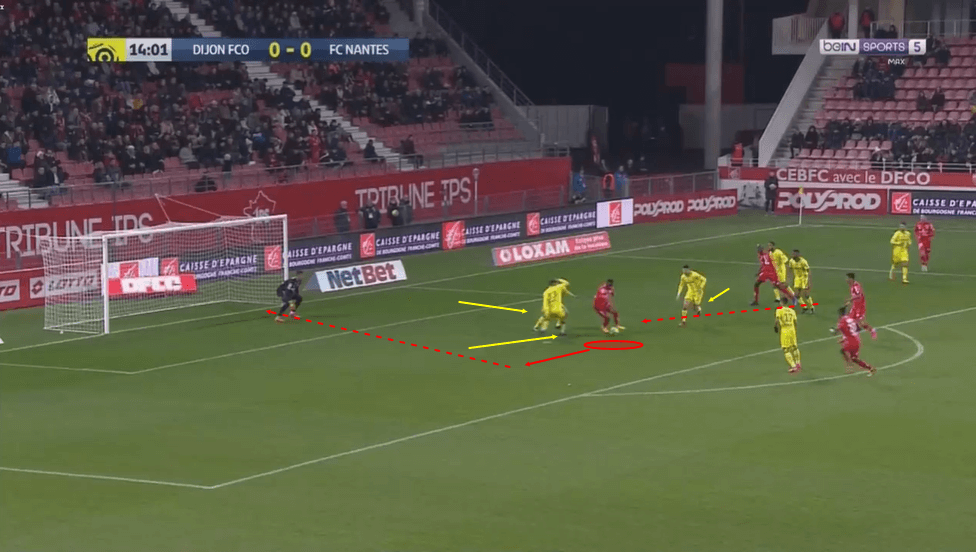
We can see an example of this situation in the image above, where Mavididi has just received the ball inside of the penalty area with his back to goal. His quickness and agility can come into play here and all he has to do is turn in order to create a 1v1 with the opposition ‘keeper, which he dispatches on this occasion.
He may be more effective when receiving the ball with his back to goal in this type of position due to firstly, the fact that opposition defenders have to be careful not to foul him in these positions and this extra level of care can make it difficult for them to stop Mavididi and secondly he doesn’t need to build up speed after turning as he does in deeper positions and instead, he can just turn and find space to get a shot off, which allows him to exploit his deadliness inside of the box.
If deployed to spearhead Montpellier’s attack next season, being allowed to make probing runs in behind and operating as a goal poacher, then that may highlight Mavididi’s biggest strengths and it would be interesting to see if he would continue to be as clinical in that situation.
Aerial duels
One negative aspect of Mavididi’s game is his relatively poor aerial ability. He contested just 1.94 aerial duels per 90 last season for Dijon, with a success rate of just 15.63% – much lower than the success rate of any Montpellier player.
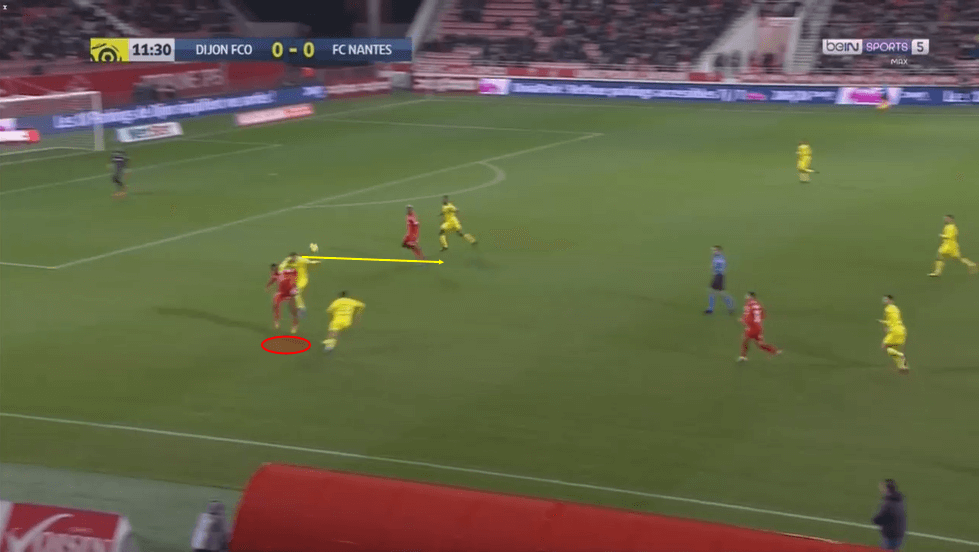
This was an obvious weakness of his game last season whilst playing for a Dijon side who contested the fifth-highest number of aerial duels per 90 in Ligue 1 last season. This image above shows us a typical example of Mavididi contesting an aerial duel and ultimately being bullied by an opposition defender last season.
Despite standing at a respectable 183cm (6’0”) tall, he struggled to impose himself in the air and this resulted in him putting up some disappointing numbers in terms of aerial duels.
Next season, this may become an even more glaring weakness of his game. Montpellier contested the second-highest number of aerial duels of any Ligue 1 side last season, while they also played the second-highest number of crosses per 90 of any Ligue 1 team.
La Paillade relied quite heavily on the aerial ability of both Laborde and Delort during the 2019/20 campaign, with Laborde contesting the ninth-highest number of aerial duels of any Ligue 1 player last season.
The fact that Mavididi can offer something to this style of play via his pace and threat of running in behind and getting onto the end of his teammates’ headers does provide a positive, however, he may need to improve on his aerial ability when moving to a Montpellier side that utilise aerial balls more than most Ligue 1 teams.
Conclusion
To conclude this tactical analysis piece in the form of a scout report, it may be fair to say that Mavididi displayed plenty of positive traits, such as his pace, dribbling, and finishing quality, for Dijon in Ligue 1 last season that bode well for him ahead of his move to Montpellier for the 2020/21 campaign.
While his lack of aerial ability may be cause for concern ahead of a move to Montpellier, whose strength in the air was a key aspect of their game last season, La Paillade may have a plan to highlight the attacker’s strengths while hiding this weakness and if so, then Mavididi could prove to be a welcome addition to Montpellier’s attacking options for next season.


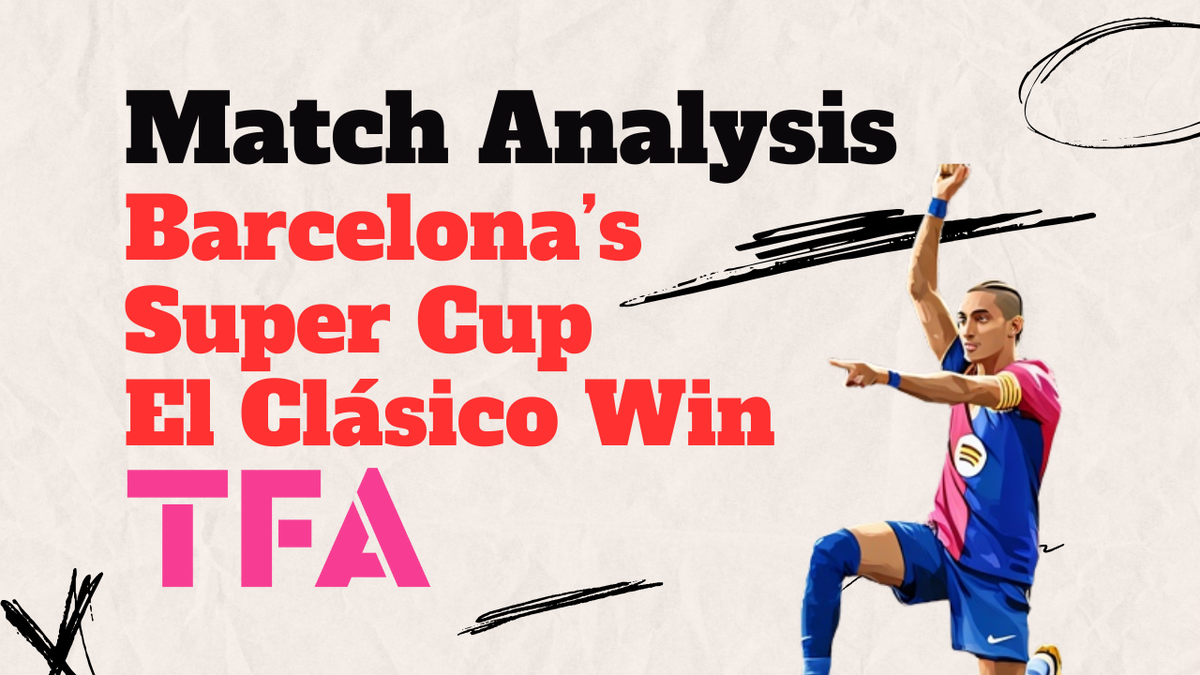
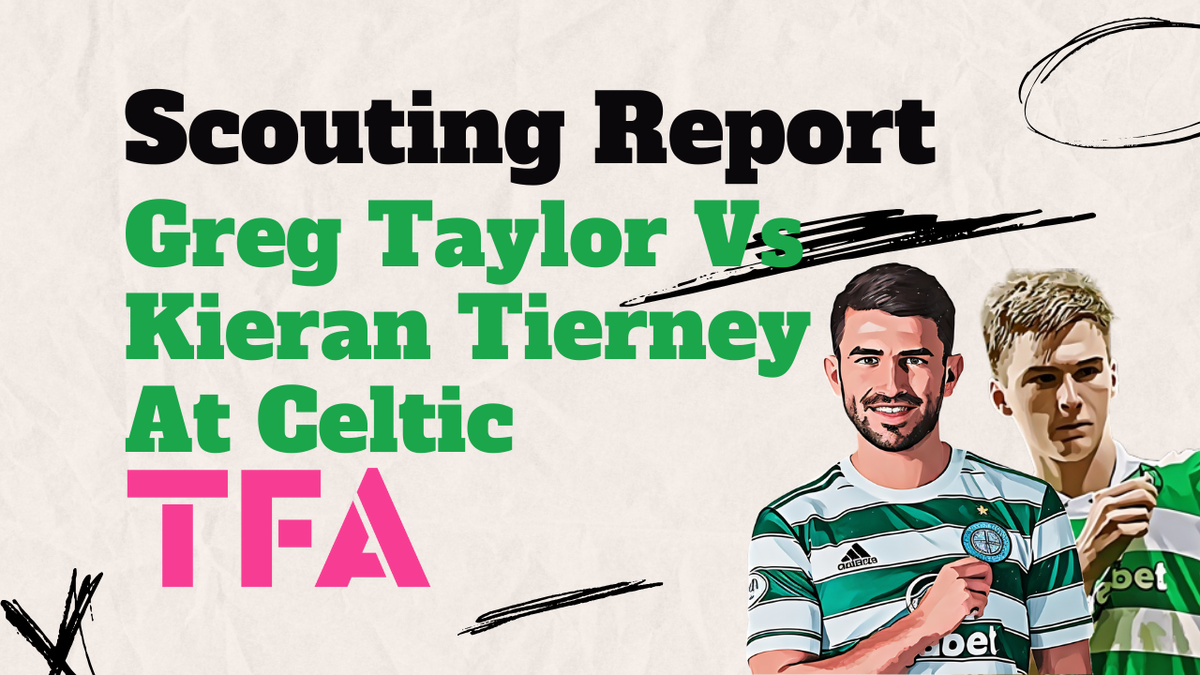
Comments